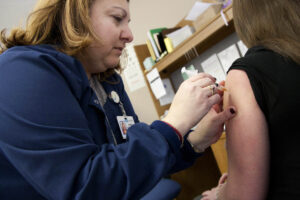
CITYWIDE — Nobody likes getting shots, but it's better to be safe than sorry.
October marks the beginning of flu season and doctors are cautioning parents and the public to get vaccinations for the flu.
Manufacturers have projected that they will produce between 135 million and 139 million doses of influenza vaccine for use in the United States during the 2013-14 flu season, according to the Centers for Disease Control and Prevention, the federal agency tasked to prevent and control disease, injury and disability.
The CDC reported an estimated 30 million to 32 million of these doses will be quadrivalent flu vaccine, or the vaccine that protects against four flu viruses. The rest will be trivalent flu vaccine.
This is the first year vaccines will be offered that have four strains, said Dennis Woo, a pediatrician at the UCLA Medical Center, Santa Monica.
Woo said having a vaccine that has four strains allows for better protection.
Denise Sur, chief of staff at the hospital, said officials are constantly tracking the virus to see what they can do ahead of an epidemic.
"Bad epidemics come when there's a strain we haven't seen before because we are completely unprotected, or an old strain which we don't include in the vaccine anymore," Sur said.
Any child six months or older should get the vaccine, Woo said.
For parents who are worried about the mercury content of the flu vaccines, Woo said there are mercury-free ones available for kids. If parents don't want to get their child vaccinated, they run the risk of their kid catching the virus.
Kids should also wash their hands "like crazy," Sur said. And if your child is sick, keep them at home from school. Pregnant women, senior citizens and smokers should also get their shots, Sur said.
Officials said last year's season wasn't "vigorous," but this year asked everyone to take the proper precautions.
"Every year, the flu changes," said Geri Braddock, nurse epidemiologist at the hospital. "The most important part of the flu program is preventing anything from happening at all."
At the hospital, Braddock makes sure patients don't get infections, consults with the doctors and nurses, does a lot of teaching and monitors the overall situation.
Flue season typically begins in October or November and can sometimes go as far as March. Flu season will peak somewhere in January or February, but it can range from season to season.
Braddock said staff and employees at the hospital get vaccinations.
Flu shots will be provided to adults and kids who are 5 years of age or older for $25 at the UCLA Santa Monica Bay Physicians, at 2424 Wilshire Blvd., at 10 a.m. Oct. 19, and 5 p.m. Oct. 22. For more information, call (310) 828-4530.
ameera@www.smdp.com








